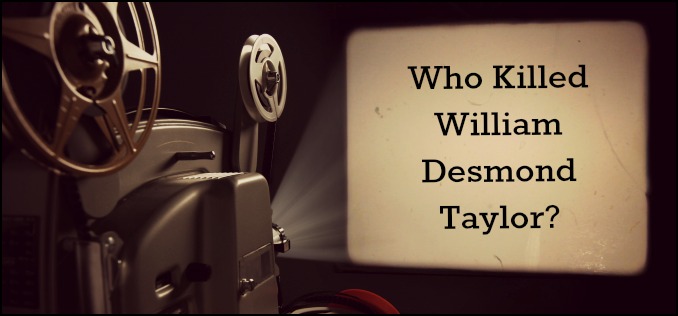
In the early days of motion pictures, William Desmond Taylor was one of the most prominent directors in Hollywood. Not only was he prolific, having supervised the filming of 59 silent movies, he was also lauded by his peers as being a refined, cultured man who was courteous to and respectful of the people with whom he worked.
It was a shattering revelation, then, when houseman Henry Peavey entered Taylor’s home in the post-dawn hours of February 2, 1922 and found the 49-year-old director’s lifeless body sprawled in his living room. Taylor had been shot to death, and Hollywood was aghast. Who on earth would have reason to kill the talented director known for such innocuous fare as Tom Sawyer and Anne of Green Gables?
Surprisingly, the list of suspects was as lengthy as Taylor’s filmography. Everyone from a disgruntled former employee to a spurned starlet was suspected of firing the fatal shot. In the end, no one was brought to justice for Taylor’s murder. Still, that hasn’t stopped nearly a century’s worth of armchair criminologists from dissecting the case and positing their own theories about the person—or persons—who killed one of the brightest stars of Hollywood’s early days.
The man whose death would serve as fodder for scores of Jazz Age gossip rags was born William Cunningham Deane-Tanner in Ireland in 1872. After a falling out with his father, the teenaged Tanner made his way to America in 1890, working first at a Kansas dude ranch, then moving to New York, where he married a woman named Ethel May Hamilton. The couple had a daughter, Ethel Daisy, and Tanner ran an antiques shop to support his family.
Life as a husband and father didn’t suit Tanner, whose wanderlust hadn’t abated since his earlier journey across the Atlantic. Tanner deserted his family in 1908 and dabbled in mining and acting for a few years before arriving in California with a new moniker (William Desmond Taylor) and a new goal—to make a name for himself in the burgeoning motion picture industry.
Taylor first worked as an actor, then became a director. He took some time away from Hollywood in 1918 and 1919 to serve in the Canadian military, but quickly resumed his career upon his return to California. As his reputation grew, Taylor became an in-demand director who worked with such silent-film stars as Mary Pickford, Wallace Reid, and Mary Miles Minter. The latter, a teenage ingénue who fell madly in love with Taylor while starring in his 1919 film Anne of Green Gables, would become one of the many people suspected of his murder.
Taylor spent the last evening of his life—February 1, 1922—drinking and chatting with comedienne Mabel Normand in his Los Angeles bungalow. Normand left at about 7:45 p.m., and 15 minutes later, neighbors heard what they later told authorities was a sound similar to that of a car backfiring. This was notable because authorities determined that Taylor had been killed at about that time, a fact that indicated the backfiring car may have actually been a discharging gun.
Perhaps it’s no surprise that Taylor’s murder has never been solved, for when Peavey discovered the director’s body on the morning of February 2, the first entity notified about the crime wasn’t the police department, but rather Taylor’s employer, Paramount. The movie studio immediately sent representatives to search Taylor’s home for letters, illegal liquor, and other items that could prove incriminating to either the director or the studio’s stars. By the time the police showed up, papers had been removed and the crime scene was being cleaned. The investigation proceeded, but with so much physical evidence lost or compromised (not to mention allegations of corruption in the police force), there was little chance of solving the Taylor murder.
So who were the suspects? Some of the most frequently cited ones are:
Mary Miles Minter—aged 19 at the time of Taylor’s death, Minter had starred in his film Anne of Green Gables, and had fallen in love with him despite the fact that he was 30 years her senior. People who knew both Minter and Taylor said that the director tried to tactfully brush off Minter’s advances. Could a humiliated Minter have killed Taylor as payback?
Charlotte Selby—Minter’s mother Charlotte Selby has also been put forth as a suspect. A stereotypically domineering “stage mother,” Selby was said to have owned a gun similar to the one that killed Taylor. Was Selby possessive enough of her daughter to kill the man who had broken Minter’s heart?
Edward Sands—For a time, serial con artist Edward Sands worked as Taylor’s houseman. Ultimately, he stole $5,000 from Taylor and disappeared, though not without sending a mocking note to Taylor under the latter’s real name, William C. Deane-Tanner. A few days before his death, Taylor began receiving hang-up phone calls. Was Sands behind them, planning to return for more of Taylor’s wealth and using the calls as a means of determining when the director would be at home?
Margaret Gibson—Silent film actress Margaret Gibson was said to have confessed to Taylor’s murder on her deathbed in 1964. She had worked with Taylor on various films, but not much is known about their relationship (if, indeed, anything beyond a professional relationship existed between the two) or her alleged motive for the crime. Was she responsible for Taylor’s death, or was her confession either a fabrication or the faulty memories of a dying woman?
Drug dealers—Taylor didn’t do drugs, but his close friend Mabel Normand most certainly did. Her vice was cocaine. Seeing how the substance was affecting her professional and personal life, Taylor repeatedly urged her to beat her addiction and, shortly before his death, was said to have been seeking avenues to bring charges against Normand’s suppliers. Did vengeful drug dealers kill Taylor as a means of staying out of prison and keeping their clutches on Normand?
Leave a Reply